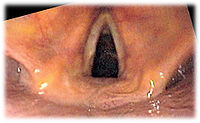
Photo from wikipedia
During laryngoscopy, the laryngoscope blade sometimes comes in contact with the teeth, fracturing or dislocating them. However, no studies have compared the effects of newly marketed video laryngoscopes and the… Click to show full abstract
During laryngoscopy, the laryngoscope blade sometimes comes in contact with the teeth, fracturing or dislocating them. However, no studies have compared the effects of newly marketed video laryngoscopes and the Macintosh laryngoscope (Mac) on teeth. In this study, we measured and compared the force exerted on the teeth of an intubating manikin by the Mac, the Airway Scope (Pentax), and the McGrath MAC (Covidien). The mean force exerted was 141.1 ± 15.7 kg by the Mac, 39.2 ± 10.3 kg by the Airway Scope, and 48.7 ± 6.7 kg by the McGrath MAC. No significant difference was observed between the Airway Scope and the McGrath MAC. When the Mac is inserted, the glottis has to be visually located from outside the oral cavity. However, a significant force is not necessary when inserting video laryngoscopes because a camera is mounted on the blade tip. In this laboratory model, the lower force exerted by the video laryngoscopes should contribute to a reduction in their impact on fracture or dislocation of teeth.
Journal Title: Anesthesia progress
Year Published: 2018
Link to full text (if available)
Share on Social Media: Sign Up to like & get
recommendations!